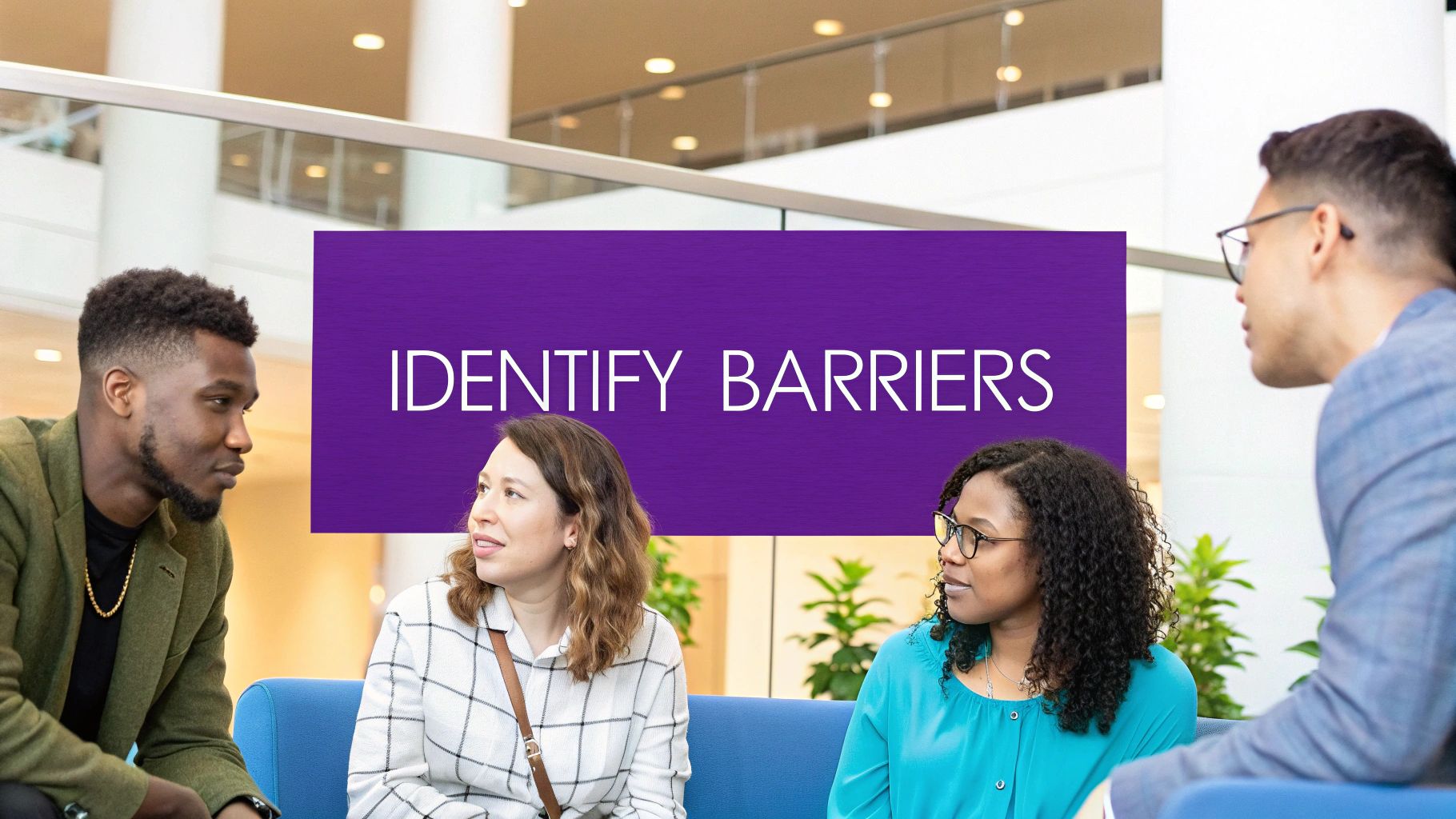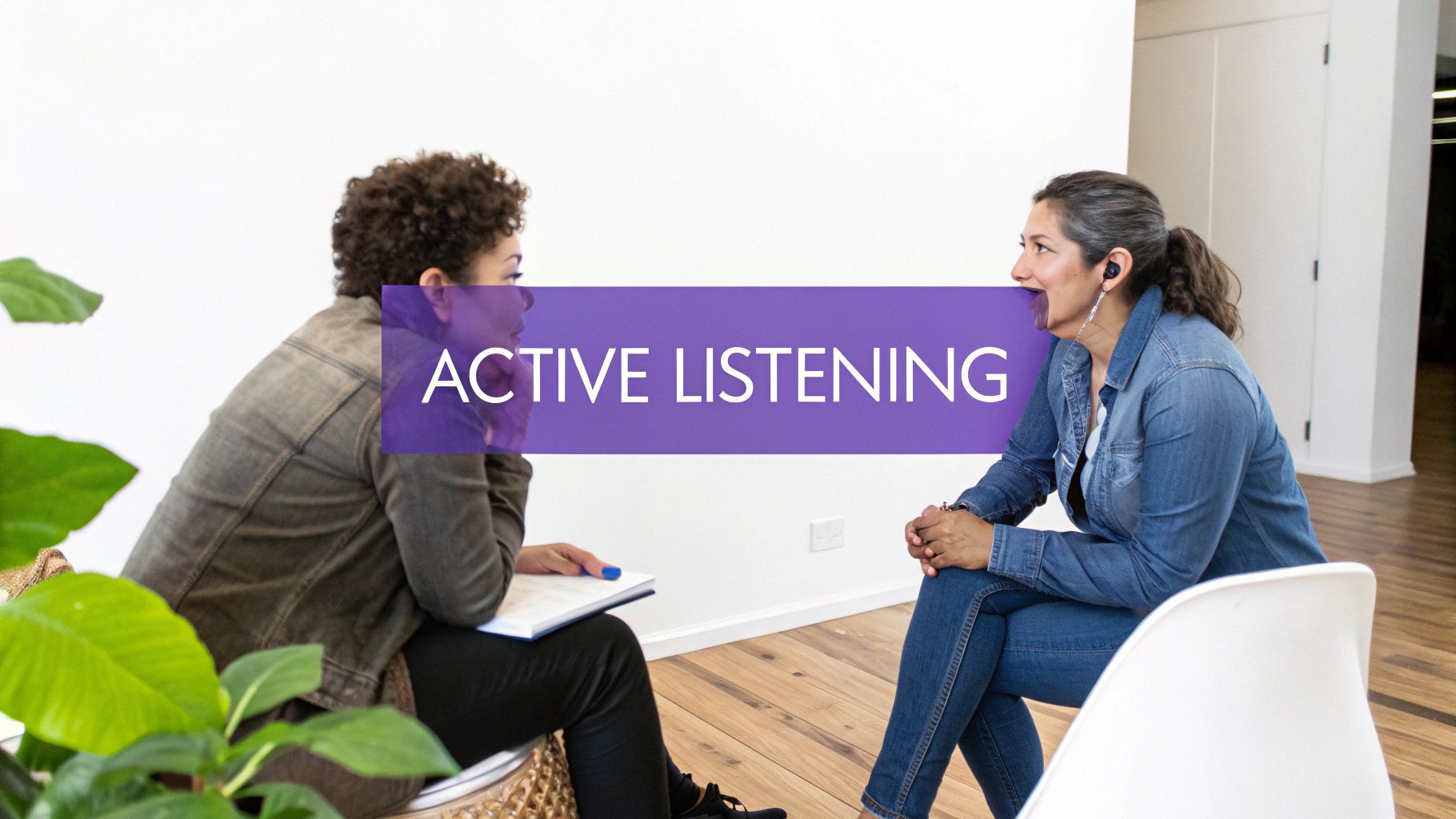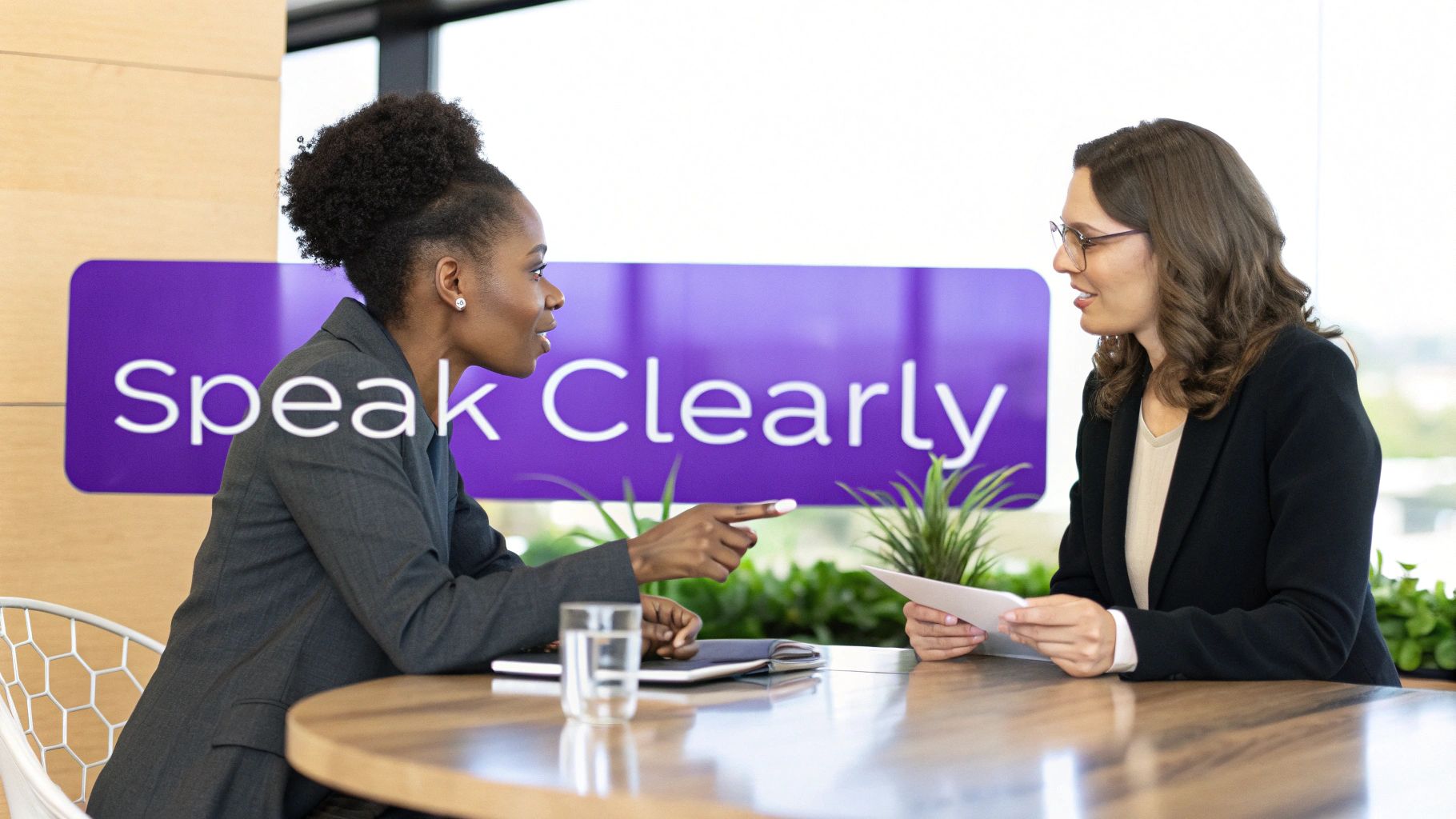The Real Cost of Communication Breakdowns

Poor communication isn't just a minor annoyance. It comes with a significant cost. This cost shows up in different ways, impacting our work, relationships, and even our health. Understanding these impacts is the first step to improving how we communicate. For further insights into communication challenges, check out this helpful resource: How to master cross-cultural communication challenges.
The Impact on Businesses
Communication breakdowns at work can lead to lower productivity, missed deadlines, and failed projects. Imagine a team preparing for a product launch. If the team miscommunicates about key deadlines, the launch could be delayed. The financial impact of such a delay could be significant, leading to lost market share and reputational damage.
Poor communication can also create conflict within teams. This can lead to a toxic work environment and high employee turnover, further impacting a company's bottom line. For example, imagine a miscommunication between the sales team and the product development team.
If the sales team promises a feature that the product team isn't aware of, it can lead to disappointed clients and damage the company’s credibility. This shows how seemingly small communication issues can escalate into bigger problems. Effective communication is essential for successful teamwork.
Overcoming communication barriers is key to improving productivity. In fact, 86% of employees and executives cite poor communication and collaboration as the main reason for workplace failures. Teams with strong communication skills can boost productivity by up to 25%. However, this requires effective communication channels, and only about two-thirds of communicators are satisfied with their current setup. Learn more about communication statistics.
The Strain on Personal Relationships
The effects of poor communication are just as significant in our personal lives. Misunderstandings can lead to tension and conflict, damaging trust and intimacy between partners, family, and friends. This can cause emotional distance and even relationship breakdowns.
Consider a situation where one partner consistently misinterprets the other's intentions. This can lead to frequent arguments and resentment. Over time, these communication issues can create a significant rift, making it difficult to rebuild the connection.
The Dangers in Healthcare
In high-stakes environments like healthcare, the consequences of communication failures can be especially serious. Medical errors, patient dissatisfaction, and negative health outcomes can result from poor communication between doctors, nurses, and patients.
A miscommunication about medication dosage, for instance, could have life-threatening consequences. These risks highlight the importance of prioritizing clear and accurate communication in healthcare. This underscores the broad impact of communication breakdowns and why developing strong communication skills is so important in all areas of life.
Beyond Words: The Hidden Impacts of Poor Communication

While it's easy to see the immediate costs of miscommunication, the hidden impacts often have a greater long-term effect. These less obvious consequences can gradually weaken team cohesion, affect individual well-being, and damage the overall health of an organization. This means getting to the root of communication problems is essential for creating a positive and productive work environment.
The Psychological Toll of Miscommunication
Repeated communication breakdowns can have a significant psychological impact. Imagine consistently feeling like your message isn't getting across or that you're not being heard. This can lead to feelings of frustration, anxiety, and resentment. These negative emotions can affect both job satisfaction and mental well-being. Over time, chronic miscommunication can also erode trust within teams, making effective collaboration a challenge.
Strained Relationships and Decreased Productivity
Misunderstandings can cause long-term tension between colleagues. A seemingly harmless email, for example, can be misinterpreted as passive-aggressive, sparking interpersonal conflict. This tension creates a negative atmosphere, impacting productivity and increasing stress. These strained relationships can even affect people outside of work, influencing social interactions and personal well-being.
Communication barriers also have a measurable impact on social relationships and health. Studies show that difficulties communicating can lead to smaller social circles, fewer positive interactions, and increased feelings of loneliness. In healthcare, poor communication contributes to about 27% of medical malpractice lawsuits and can negatively impact patient satisfaction. Learn more about the social and health impacts of communication barriers.
To further understand the various impacts of poor communication, let's look at the following table:
The Cost of Communication Barriers
| Sector | Financial Impact | Other Consequences |
|---|---|---|
| Business | Lost productivity, increased employee turnover | Damaged client relationships, decreased employee morale, project delays |
| Healthcare | Medical malpractice lawsuits, increased hospital readmissions | Decreased patient satisfaction, medical errors, compromised patient safety |
| Social Relationships | Difficulty forming and maintaining relationships | Increased loneliness, social isolation, decreased overall well-being |
This table summarizes the key consequences of communication problems across different areas, showing the broad reach of these issues. As you can see, the effects go beyond simple misunderstandings and can have profound impacts on finances, relationships, and well-being.
The Financial Ripple Effect
The financial consequences of poor communication are more than just the immediate expenses. Lost productivity, higher employee turnover, and damaged client relationships all contribute to significant financial losses. These losses can be especially damaging to small businesses or startups with limited resources. This underscores the importance of investing in communication training and developing strategies to address these challenges. Taking proactive steps can save businesses time, money, and a great deal of stress.
Active Listening: The Most Underrated Communication Skill

Many people assume they're good listeners. However, true active listening is a rare skill that can completely change how we communicate. It's much more than just hearing words. It involves understanding the entire message, including both verbal and nonverbal communication. This section explores how developing active listening skills can significantly improve our connections with others and help us overcome communication barriers.
The Power of Understanding
Active listening isn't about waiting for your chance to speak. It's about genuinely focusing on the speaker. This involves absorbing their words and interpreting their nonverbal cues. Pay attention to their body language, tone of voice, and facial expressions. For example, someone might say they're fine, but their slumped posture and averted gaze might tell a different story. This deeper level of understanding creates more meaningful and productive conversations.
Key Components of Active Listening
Active listening involves a few key techniques. When practiced regularly, these techniques can greatly improve your communication skills:
-
Asking Clarifying Questions: Don't be afraid to ask questions to make sure you truly understand what the speaker is saying. This shows you're interested and helps uncover any hidden meanings.
-
Reflecting and Paraphrasing: Summarizing the speaker's main points in your own words is a good way to confirm your understanding and gives them a chance to correct any misinterpretations. You can do this by simply saying, "So, if I understand correctly…"
-
Empathy and Validation: Acknowledging the speaker's feelings, even if you don't necessarily agree with their perspective, creates a safe space for open communication. This encourages them to share more openly and honestly.
Common Listening Mistakes
Even experienced communicators can fall into common listening traps. These mistakes can create barriers and prevent effective communication:
-
Interrupting: Interrupting someone mid-sentence sends a clear message: their thoughts aren't as important as your own. This can quickly shut down communication and cause resentment.
-
Prematurely Offering Solutions: Jumping in with solutions before fully grasping the problem can be unhelpful. It’s essential to listen carefully before trying to fix anything.
-
Multitasking: Trying to listen while also checking emails or doing other tasks divides your attention. This can lead to missed details and misinterpretations.
Overcoming Internal Barriers to Listening
Our own internal biases and assumptions can hinder effective listening. Recognizing and addressing these internal barriers is crucial for becoming a better listener:
-
Preconceived Notions: Going into a conversation with pre-formed opinions can prevent you from hearing what the other person is actually saying. Approach conversations with an open mind.
-
Emotional Reactions: Strong emotional responses can cloud our judgment and make it difficult to listen objectively. Take a moment to manage your own emotions before responding. This can drastically improve communication.
By mastering active listening, we can handle challenging conversations more easily and develop stronger relationships, both personally and professionally. This vital skill is a powerful tool for breaking down communication barriers and building genuine connections.
Digital Tools That Actually Improve Communication

Technology offers many tools to improve communication and overcome obstacles. Choosing the right tool for your needs is key. This section explores technologies that truly help us communicate better. For remote teams, check out this helpful resource: Collaboration tools for remote teams. These tools can significantly change how teams interact, improving efficiency and making communication more effective.
Collaboration Platforms For Seamless Teamwork
Collaboration platforms are vital for teams spread across different locations. These tools offer a central hub for communication, file sharing, and project management. This allows team members easy access to information, anytime, anywhere. For instance, platforms like Slack and Microsoft Teams offer instant messaging, video conferencing, and file storage. This fosters real-time communication and collaboration.
Translation Services: Bridging Language Gaps
Language barriers can significantly hinder communication. Thankfully, real-time translation services are getting better at breaking down these barriers. Tools like Google Translate and DeepL can instantly translate text and even speech, helping people who speak different languages communicate. This ability is incredibly valuable in our global world, connecting businesses and individuals across borders.
Accessibility Solutions For Inclusive Communication
Accessibility is a vital part of effective communication. Assistive technologies help ensure that everyone can participate, regardless of physical limitations. Screen readers, for example, allow visually impaired individuals to access digital text. Speech-to-text software helps those who have difficulty typing. Closed captioning and transcription services make audio and video content accessible to a wider audience, including those with hearing impairments.
To help choose the best communication technology, we've created the following comparison table:
Communication Technology Comparison: A comparison of different technologies for overcoming specific communication barriers.
| Technology Type | Best For | Limitations | Cost Range |
|---|---|---|---|
| Collaboration Platforms (e.g., Slack, Microsoft Teams) | Team communication, file sharing, project management | Requires internet access, can be overwhelming with many users | Free to paid plans (based on features and users) |
| Translation Services (e.g., Google Translate, DeepL) | Overcoming language barriers in written and spoken communication | Accuracy can vary, context can be lost in translation | Free to paid plans (based on usage and features) |
| Accessibility Solutions (e.g., screen readers, speech-to-text software) | Inclusive communication for individuals with disabilities | Requires specific software or hardware, can have a learning curve | Free to paid plans (depending on the specific tool) |
| Diagramming Tools (e.g., Cacoo) | Visual communication and collaboration | Requires software license | Paid plans based on usage and features |
This table highlights the strengths and weaknesses of each technology, making it easier to select the best fit for your needs. Remember, choosing the right technology can significantly impact communication effectiveness.
Choosing the Right Technology
Choosing the right technology depends on your communication challenges. For a global team, a collaboration platform with translation features might be crucial. For visually focused teams, a diagramming tool like Cacoo can improve understanding. Integrating tools can boost efficiency. Linking a project management tool with a communication platform can streamline workflows and keep everyone updated.
Maintaining the Human Connection
While digital tools are helpful, keeping the human element in communication is important. Technology should help, not replace, interpersonal interaction. When using these tools, prioritize clear, empathetic, and respectful communication. Active listening is still essential, even online. Combining the right technology with strong interpersonal skills helps overcome communication barriers and build strong connections.
Building Communication Skills That Transfer Across Settings
True communication mastery isn't about reciting memorized lines. It's about developing a flexible skill set applicable to any situation. Think of it like learning a new language: once you grasp the core principles, you can converse in various settings. This section explores how education and training can cultivate these adaptable communication skills.
Essential Skills for Effective Communication
Several key skills form the bedrock of effective communication, regardless of the context:
-
Active Listening: This involves more than just hearing words. It's about truly understanding the speaker's message, including their nonverbal cues. It requires being present and engaged in the conversation.
-
Clear and Concise Messaging: Express your thoughts and ideas simply and directly. Avoid jargon and ambiguity to ensure your message is easily understood.
-
Nonverbal Communication Awareness: Body language, tone of voice, and facial expressions significantly impact communication. Be mindful of your own nonverbal cues and learn to interpret those of others.
-
Conflict Resolution: Navigating disagreements constructively is essential. This involves active listening, empathy, and finding solutions that work for everyone involved.
-
Cross-Cultural Communication: In our increasingly globalized world, understanding cultural nuances in communication is crucial for respectful and effective interactions.
Adapting Communication Skills to Different Environments
These core communication principles can be applied across diverse environments:
-
Workplace: Effective communication in the workplace promotes teamwork, boosts productivity, and strengthens relationships with colleagues and clients.
-
Personal Relationships: Strong communication skills improve understanding, minimize conflict, and deepen connections with family and friends.
-
Healthcare: Clear communication in healthcare is vital for patient safety, satisfaction, and positive health outcomes.
-
Education: Overcoming communication barriers in education also involves teaching students about diverse communication styles. For instance, Okanagan College offers courses that help students identify and discuss communication barriers and learning styles. This equips students to become more effective communicators in various settings, especially in industries requiring seamless interaction between teams and clients.
Implementing Effective Communication Training
Many organizations now recognize the value of communication skills and are investing in training programs. These programs often use evidence-based methods to teach essential skills. This investment not only improves internal communication but also strengthens relationships with clients and stakeholders.
Assessing and Improving Your Communication Skills
The first step towards improvement is identifying your communication strengths and weaknesses. Several assessment methods can help, including self-reflection, feedback from others, and formal assessments. This targeted approach allows you to focus your efforts where they're needed most. By consistently practicing and refining these skills, you can become a more confident and effective communicator in any situation.
Emotional Intelligence: The Communication Superpower
While technical skills are important, emotional intelligence (EQ) plays a crucial role in successful communication. This section explores how developing your emotional awareness can transform difficult conversations and help you overcome interpersonal barriers. EQ involves understanding and managing your own emotions, as well as recognizing and responding effectively to the emotions of others.
Recognizing Emotional Triggers
Improving your EQ starts with identifying your emotional triggers. These are specific situations or behaviors that provoke strong emotional responses. For example, a condescending tone might make you defensive, or constant interruptions might leave you feeling unheard. Recognizing these triggers is the first step towards managing your reactions more effectively. For more insights, check out this resource: How to master your emotional intelligence.
Managing Your Responses in High-Stakes Interactions
Once you understand your triggers, you can begin to manage your reactions. Practice self-regulation techniques to maintain composure during challenging conversations. If you feel yourself getting angry, take a deep breath or pause before responding. This helps you respond thoughtfully, rather than reacting impulsively, leading to more productive communication.
Reading Emotional Cues in Others
EQ also involves accurately reading emotional cues in others. Pay attention to nonverbal communication like body language, tone of voice, and facial expressions. Just as your nonverbal cues speak volumes, so do the cues of others. A colleague avoiding eye contact, for instance, might be feeling anxious or uncertain. Recognizing these cues allows you to tailor your communication for greater empathy and effectiveness.
Creating Psychological Safety for Open Dialogue
Effective communicators understand the power of psychological safety. This is an environment where individuals feel comfortable sharing their thoughts and feelings without fear of judgment or negative repercussions. Psychological safety is crucial for overcoming communication barriers, especially when discussing sensitive topics. In a psychologically safe team meeting, for example, members are more likely to express concerns and share innovative ideas, even if those ideas differ from the majority opinion.
Adapting Your Approach Based on Emotional Context
Effective communication isn't one-size-fits-all. It requires adapting your communication style to the emotional context. Consider the other person's emotional state and tailor your message accordingly. If someone is upset, acknowledge their feelings and approach the conversation with empathy. Conversely, when sharing exciting news, use a more enthusiastic tone. By becoming more attuned to the emotional context, you can navigate complex interpersonal dynamics and turn potentially difficult conversations into opportunities for connection and understanding. This, in turn, builds stronger relationships and fosters a more positive communication environment.
Creating Environments Where Open Communication Thrives
The environments we communicate in, both physical and psychological, heavily influence how effectively we connect. Intentionally designing these spaces is key to overcoming communication barriers and fostering authentic exchange. This section explores research-backed strategies for creating environments optimized for productive, open communication.
Designing Physical Spaces for Communication Success
The physical layout of a workspace significantly impacts communication patterns. An open-plan office, while promoting spontaneous interaction, can also lead to distractions and difficulty focusing during sensitive conversations. Conversely, individual offices offer privacy but can isolate employees and hinder collaboration. We need diverse spaces that cater to various communication needs.
-
Collaborative Zones: Design open areas with flexible furniture for brainstorming and teamwork. Whiteboards, interactive displays, and comfortable seating encourage interaction and idea generation.
-
Private Spaces: Dedicated quiet rooms or soundproof booths are essential for confidential discussions or focused work. These offer privacy and minimize distractions, enabling more productive conversations.
-
Meeting Rooms Optimized for Purpose: Consider the meeting's goal when selecting a room. A room with a projector and ample seating is ideal for presentations. A round table in a less formal setting might be more effective for smaller team discussions.
Cultivating a Positive Psychological Environment
Just as crucial as the physical space is the psychological environment – the overall atmosphere of trust, respect, and openness. In a positive psychological environment, people feel safe expressing themselves honestly and respectfully, even when sharing dissenting opinions. This fosters open dialogue and encourages unique perspectives.
-
Establishing Trust and Psychological Safety: Leaders are crucial in fostering trust. Actively listening to employees, valuing their input, and responding constructively to feedback are key. Openly acknowledging mistakes and demonstrating vulnerability also builds trust and creates a safe space for communication.
-
Promoting Respectful Communication: Establish clear expectations for respectful dialogue. Discourage interrupting, personal attacks, and dismissive language. Encourage active listening and empathy to ensure all voices are heard and valued. This promotes a culture where individuals feel comfortable sharing their perspectives without fear of judgment.
-
Valuing Diverse Voices: Creating inclusive environments where everyone feels empowered to speak up is key to overcoming communication barriers. This requires recognizing and addressing unconscious biases that might marginalize certain individuals or groups. Leaders should actively seek out and value diverse perspectives, ensuring everyone feels comfortable contributing their unique insights.
Learning from Organizations That Mastered Inclusive Communication
Many organizations demonstrate how intentionally designed environments positively impact communication. Some companies implement flexible work arrangements that cater to diverse needs. Others prioritize accessibility by offering assistive technologies and providing communication training focused on inclusivity. These examples show how leaders can systematically identify and remove environmental barriers. By prioritizing both physical and psychological factors, they create spaces where open communication thrives.
By understanding the profound influence of both physical and psychological environments, we can intentionally design spaces that facilitate communication success. This involves considering the communication's purpose, the emotional context, and the individual needs of those involved. Creating these supportive environments empowers authentic and effective connections, leading to stronger relationships and more productive outcomes.
Ready to boost your team’s communication? Bulby, a brainstorming platform for remote teams, offers AI-powered guidance and research-backed exercises to help you break through communication barriers. Transform your team's communication with Bulby today!

